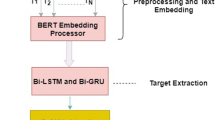Abstract
In this digital era, people are increasingly sharing their opinions in online review sites, and vast amounts of customer feedback are generated daily. Many customers make use of these unstructured text reviews feedback for their decision making. However, the customer feedback is exponentially huge, and reading all the reviews is tedious. Due to the maximum length of sentences, textual order changes, and logical complications, it is still a challenging area to predict the exact sentiment polarities of the user textual feedback reviews for a given entity. To address these problems, we introduce Bi-LSTM Self Attention based Convolutional Neural Network (BAC) model for subjectivity classification of reviews. In our approach, we employ pre-trained word embedding to reduce the dimension of the text representation, which avoids data sparsity issues. We also apply an attention mechanism to capture n-gram features and focus on the crucial information from the context by setting different weights between words and sentences. The proposed model uses CNN and Bi-LSTM to automatically learn classification features as well as capture the semantic and contextual information which is crucial in determining the sentiment polarities. To assess the performance of the proposed BAC model, it is compared with other baseline methods. The proposed model has achieved the accuracy of 89% and the F1-measure value of 91%.








Similar content being viewed by others
Explore related subjects
Discover the latest articles, news and stories from top researchers in related subjects.References
Chen Z, Xu R, Gui L, Lu Q (2015) Combining convolutional neural networks and word sentiment sequence features for Chinese text sentiment analysis. J Chin Inf Process 29(6):172–178
De Mulder W, Bethard S, Moens MF (2015) A survey on the application of recurrent neural networks to statistical language modeling. Comput Speech Lang 30(1):61–98
Deng L, Yu D (2014) Deep learning: methods and applications. Foundations and trends in signal processing 7(3–4):197–387
Dong L, Wei F, Tan C, Tang D, Zhou M, Xu K (2014) Adaptive recursive neural network for target-dependent twitter sentiment classification. In: Proceedings of the 52nd annual meeting of the association for computational linguistics (volume 2: short papers), pp 49–54
Geng Z, Chen G, Han Y, Lu G, Li F (2020) Semantic relation extraction using sequential and tree-structured LSTM with attention. Inf Sci 509:183–192
Gu J, Wang Z, Kuen J, Ma L, Shahroudy A, Shuai B, Liu T, Wang X, Wang G, Cai J, Chen T (2018) Recent advances in convolutional neural networks. Pattern Recogn 77:354–377
Horrigan J (2008) Online shopping. Pew Internet & American Life Project. Washington, DC available at: http://www.pewinternet.org/Reports/2008/Online-Shopping/01-Summary-of-Findings.aspx. Accessed 8/8/2014.
Johnson R, Zhang T (2015) Semi-supervised convolutional neural networks for text categorization via region embedding. Adv Neural Inf Proces Syst 28:919–927
Ke C, Bin L, Wende K, Bo X, Guochao Z (2018) Chinese micro-blog sentiment analysis based on multi-channels convolutional neural networks. J Comput Res Dev 55(5):945
Li W, Qi F, Tang M, Yu Z (2020) Bidirectional LSTM with self-attention mechanism and multi-channel features for sentiment classification. Neurocomputing 387:63–77
Li L, Goh TT, Jin D (2020) How textual quality of online reviews affect classification performance: a case of deep learning sentiment analysis. Neural Comput & Applic 32(9):4387–4415
Liu B (2012) Sentiment analysis and opinion mining. Synthesis lectures on human language technologies 5(1):1–167
Mikolov T, Chen K, Corrado G, Dean J (2013) Efficient estimation of word representations in vector space. arXiv preprint arXiv:1301.3781
Rathor AS, Agarwal A, Dimri P (2018) Comparative study of machine learning approaches for Amazon reviews. Proc Comput Sci 132:1552–1561
Tang D, Qin B, Liu T (2015) Document modeling with gated recurrent neural network for sentiment classification. In: Proceedings of the 2015 conference on empirical methods in natural language processing, pp 1422–1432
Tang D, Qin B, Liu T (2015) Learning semantic representations of users and products for document level sentiment classification. In: Proceedings of the 53rd annual meeting of the Association for Computational Linguistics and the 7th international joint conference on natural language processing (volume 1: long papers), pp 1014–1023
Wang P, Li J, Hou J (2021) S2SAN: a sentence-to-sentence attention network for sentiment analysis of online reviews. Decis Support Syst 113603:113603
Xie J, Chen B, Gu X, Liang F, Xu X (2019) Self-attention-based BiLSTM model for short text fine-grained sentiment classification. IEEE Access 7:180558–180570
Yuan J, You Q, Luo J (2015) Sentiment analysis using social multimedia. In: Multimedia data mining and analytics. Springer, Cham, pp 31–59
Yue W, Li L (2020) Sentiment analysis using Word2vec-CNN-BiLSTM classification. In: 2020 seventh international conference on social networks analysis, management and security (SNAMS). IEEE, pp 1–5
Author information
Authors and Affiliations
Corresponding author
Additional information
Publisher’s note
Springer Nature remains neutral with regard to jurisdictional claims in published maps and institutional affiliations.
Rights and permissions
About this article
Cite this article
Bhuvaneshwari, P., Rao, A.N., Robinson, Y.H. et al. Sentiment analysis for user reviews using Bi-LSTM self-attention based CNN model. Multimed Tools Appl 81, 12405–12419 (2022). https://doi.org/10.1007/s11042-022-12410-4
Received:
Revised:
Accepted:
Published:
Issue Date:
DOI: https://doi.org/10.1007/s11042-022-12410-4




